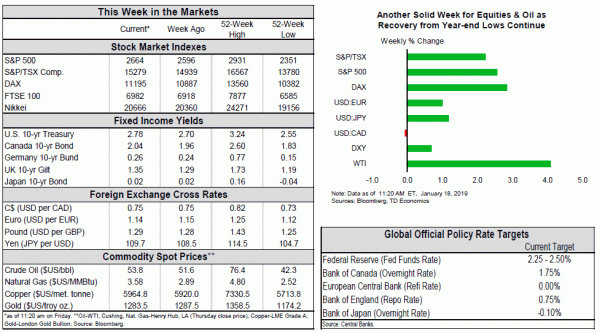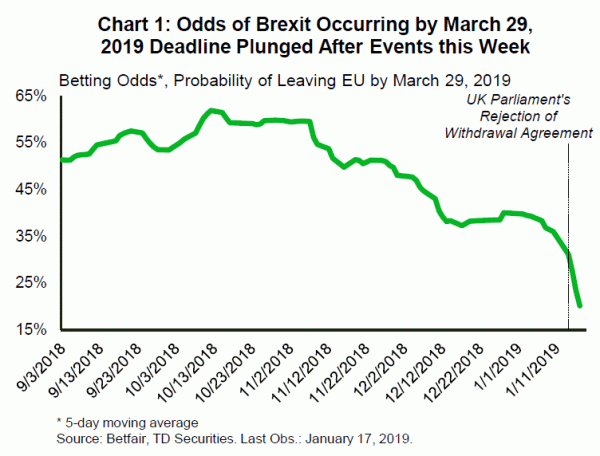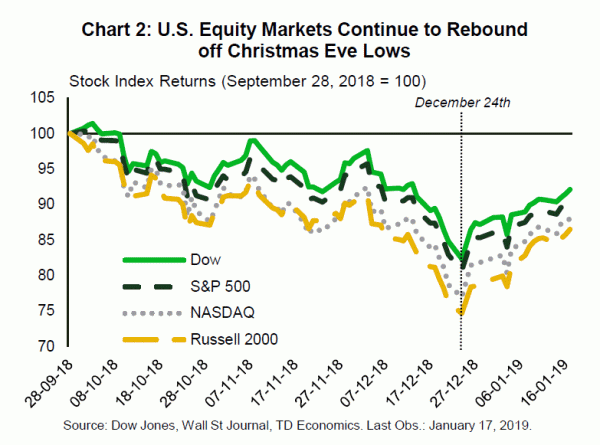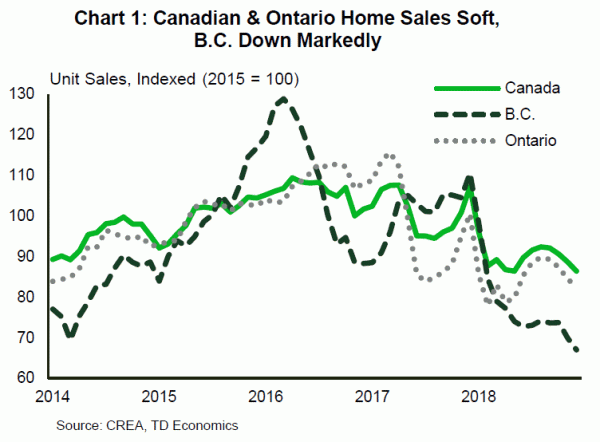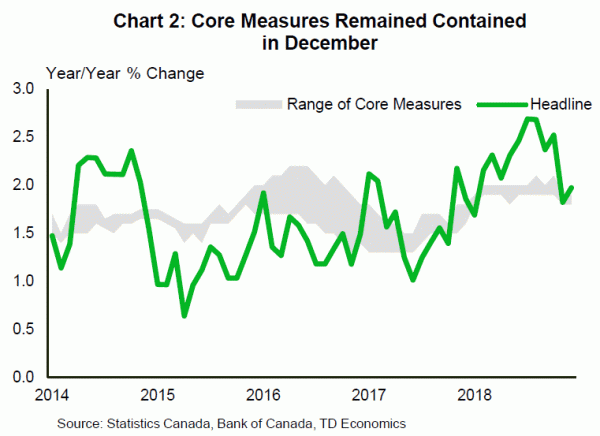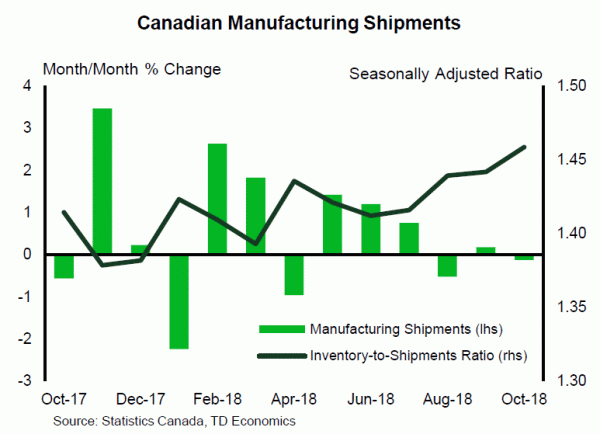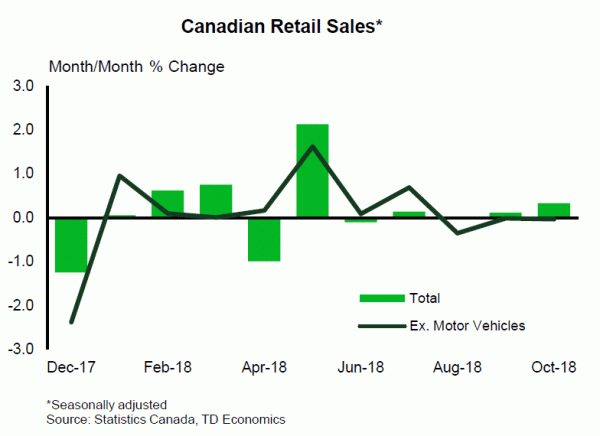U.S. Highlights
- The government shutdown extended to its 28th day, making it the longest on record with no clear end in sight.
- The White House upped its estimate of the impact of the government shutdown to a 0.5ppt drag on 19Q1 growth after four weeks. This is much higher than private sector estimates of between -0.1 to -0.2 ppts.
- As expected, the Brexit withdrawal agreement was soundly rejected by UK parliament. With the March 29th deadline fast approaching, it looks increasingly likely that the UK will have no choice but to seek an extension from the EU.
Canadian Highlights
- Recent Canadian housing data painted a somber picture. Existing home sales were down 2.5% month-on-month in December, their fourth straight monthly decline. B.C. and Ontario were largely to blame.
- Headline inflation came in ahead of market expectations at 2.0% year-on-year, due in large part to a seasonal surge in airfares. Beneath the surface there is little to get worked up about as core inflation was unchanged.
- The U.S. shutdown is making itself felt north of the border: Statistics Canada will delay the trade data until they receive figures from their American counterparts.
U.S. – Dysfunctional Governments on Parade
Now in its 28th day, the U.S. government shutdown has far exceeded the 21-day shutdown record set in 1995-96 with no clear end in sight. The longer the shutdown lingers, the higher the likelihood that some of the negative economic impacts from the shutdown gain permanency. As an example, this week the White House doubled its estimated economic impact of the shutdown. Previous estimates assumed a drag of about 0.1 percentage points off of first quarter growth for every two weeks of the shutdown. But, after incorporating the impact of contract workers not being paid, the estimate rises to about -0.13 percentage points off growth each week. This suggests that after four weeks the shutdown is estimated to have shaved half a point off of first quarter GDP growth. This estimate is well above other private sector estimates that expect a more modest impact on growth of about 0.1ppt drag for every three weeks or so that the shutdown lingers.
The shutdown is exacting a toll on those least responsible for it. Anecdotes continue to highlight the hardships that furloughed federal employees are experiencing. These include workers turning to payday loan companies and food banks, while also taking on side hustles, such as driving for Uber, in order to make ends meet. Although federal employees will eventually be paid for lost wages, the near-term pain is clearly taking a toll.
Across the pond, Brexit developments in the UK this week signaled that government dysfunction is not solely a U.S. pastime. After weeks of anticipation, the withdrawal agreement was put to a vote and was soundly rejected by parliament. The next day, Theresa May’s government survived a confidence vote, concluding a tumultuous week. Next steps include consultations between the prime minister and other parties on proposed amendments to the withdrawal agreement set to be tabled on January 21st, but not voted upon until January 29th. With the March 29th deadline fast approaching, it looks increasingly likely that the UK will have no choice but to seek an extension from the EU (Chart 1).
Despite the government dysfunction on display on both sides of the Atlantic, financial markets were largely unfazed. U.S. equity indexes have soared since the New Year, and are now back at levels seen in early December (Chart 2). There’s good reason for optimism. Data still being reported, such as weekly initial jobless claims, continued to signal a healthy economy. Trade talks with China are ongoing, with the next round set to take place on January 30th in Washington. Although little progress has been announced so far, news that U.S. officials were discussing ratcheting back some of the tariffs on Chinese imports in order to encourage an agreement helped to stoke a global rally in risk assets. Perhaps more importantly, Federal Reserve Presidents were out delivering speeches that reinforced the Fed’s willingness to be patient before the next rate hike. Indeed, patience is warranted given uncertainty about the economic impact of the government shutdown, and ongoing concerns about the health of the global economy.
Canada – Under (Little) Pressure
It looks to have been a solid week for Canadian markets, with the S&P/TSX composite index performing well. In fact, as of Thursday’s close, the index was up 6.2% year-to-date, making it among the top performing global indices. A constructive energy price environment is likely helping. The headline WTI oil contract sat at around $53 per barrel at the time of writing, still soft, but off its December lows. Even more impressive has been the change in heavy oil pricing, now up to the $40 range, a quadrupling relative to the worst of December.
Away from markets, it was a somewhat more somber week on the data front. Existing home sales were down 2.5% month-on-month in December, marking a fourth straight monthly decline (Chart 1). B.C. and Ontario led the decline. In Ontario, the post B-20 summer 2018 sales bump has given way to softer conditions, with sales back to 2014 levels. Prices held up better, with the average sale price ending 2018 pretty much where it ended 2017.
B.C., in contrast, did not have a summer sales bump as provincial cooling measures have continued to weigh on activity. Much like Ontario, average prices seem to have levelled off somewhat, perhaps reflecting a relatively small amount of supply for sale to date. For both B.C. and Ontario, there is little reason to expect this to change. The number of units under construction in these provinces is elevated, but is a far cry from the levels seen before the early-1990s housing adjustment once current populations are taken into account. It remains our view that the most likely path forward is for sales growth to remain subdued, with constrained affordability playing off against fundamental demand to leave little in the way of upward price pressure. This may be a big change from recent years, but is not without precedent: almost the entirety of the 1990s looked this way. Adjust your expectations accordingly.
On the topic of prices, the December CPI figures were exciting on their face as a surge in airfares drove the headline figure to 2.0%, beating market expectations of a 1.7% print. Beneath the surface however, there was little in the way of fundamental pressures (Chart 2). The core measures were unchanged as much of the headline surprise was due to a (seasonal) surge in airfares – a grain of salt is needed here as a calculation change by Statistics Canada makes year-on-year comparisons difficult. Suffice it to say that fundamental price pressures remained tame at the close of 2018.
Finally, the U.S. government shutdown has begun to hit Canadians, as Statistics Canada announced this week that the December trade data would be delayed until their U.S. counterparts are able to provide import data. This doesn’t mean too much in the near-term, and Statistics Canada plans to release GDP data as normal at the end of next month. But, should the shutdown persist, we, and more importantly the Bank of Canada, will have a challenging time assessing Canada’s trade performance, an area given particular focus in the latest Monetary Policy Report, and yet another item for a “hold off on the next hike” checklist.
Canada: Upcoming Key Economic Releases
Canadian Manufacturing Sales – November
Release Date: January 22, 2019
Previous: -0.1%
TD Forecast: -0.4%
Consensus: N/A
TD looks for manufacturing sales to decline by 0.4% in November on weaker petroleum sales, reflecting a sharp drop in gasoline prices. Auto production estimates were also lower throughout the month, which fits with a pullback in imported automotive parts to suggest weaker factory sales of motor vehicles. However, lower prices for petroleum products should be partially offset by a return to normal operations at the Irving Refinery in St. Johns; maintenance shutdowns caused New Brunswick’s non-durable output to fall by 13% m/m in October, shaving 0.2pp from total manufacturing sales. Despite our forecast for a negative headline print, real manufacturing sales should post a modest increase in November owing to a 0.8% decline in factory prices (ex petrol: +0.2%) which suggests a slight tailwind to industry-level GDP from the manufacturing sector
Canadian Retail Sales – November
Release Date: January 23, 2019
Previous: 0.3%, ex-auto: 0.0%
TD Forecast: -0.6%, ex-auto: -0.4% m/m
Consensus: N/A
Lower gasoline prices will exert a heavy drag on retail activity for November, with nominal retail sales forecast to decline by 0.6% m/m. Much of this is attributable to the price at the pump, which fell by nearly 10% throughout the month – only slightly less than the largest one-month drop during the 2014/15 period. This should shave roughly 0.5pp from the headline print while a pullback in motor vehicle sales will also weigh on monthly sales activity, leaving ex-auto sales 0.4% lower. Offsetting weakness in motor vehicles and gasoline sales will be a rebound in core retail activity after posting a 0.4% decline in October, the largest in 2018. However, since much of the decline will be driven by lower prices the impact on growth should be more modest than the headline print implies, with real retail sales down roughly 0.2 m/m.




